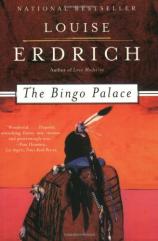Reading Group Guide
Discussion Questions
The Bingo Palace

1. The word "luck" appears frequently in the novel: it figures in the titles of nine chapters and is invoked as a way to explain why things happen the way they do. But the novel also makes cases for fate (in forces outside of the everyday) and for design (for instance, Lipsha discovers that his "luck" in bingo is really Lyman's scheme to siphon money back to himself). In what ways does the novel explore questions of chance, fate, and will? What does luck seem to mean in the different chapters featuring it? How do specific characters (such as Lipsha, Lyman, Shawnee Ray, Zelda) exemplify the intricacies of fortune, the pressures of the past, and the problems of constructing a life for oneself? How are Juno's ghost and Fleur used to extend conventional ideas about the nature of fate and reality?
2. Critics have occasionally noted that the men and women in Erdrich's novels seem to live in entirely separate worlds. Do you feel this observation applies to The Bingo Palace ? How would you describe the separate worlds of the men and women? Does the novel offer any real points of intersection between the two?
3. Why are Lipsha and Lyman so different? Are there events in their pasts that caused them to be so different? How and why does Lipsha change? What does he come to understand about himself? Lyman? Shanwee Ray? his parents? Do you think that the novel is a cautionary tale about the dangers of trying to go home again, or a story about the value and necessity of returning to one's home?
4. One motif of Native American literature is the vision quest. How is this used in The Bingo Palace? What kinds of quests occupy specific characters (especially Lipsha, Lyman, Shawnee Ray)? Do you think the novel demonstrates that spiritual and material quests are necessarily opposed? How do you feel about this--do you feel an inherent conflict between spiritual and material goals and desires?
The Bingo Palace
- Publication Date: February 15, 1995
- Paperback: 288 pages
- Publisher: Harper Perennial
- ISBN-10: 006092585X
- ISBN-13: 9780060925857







